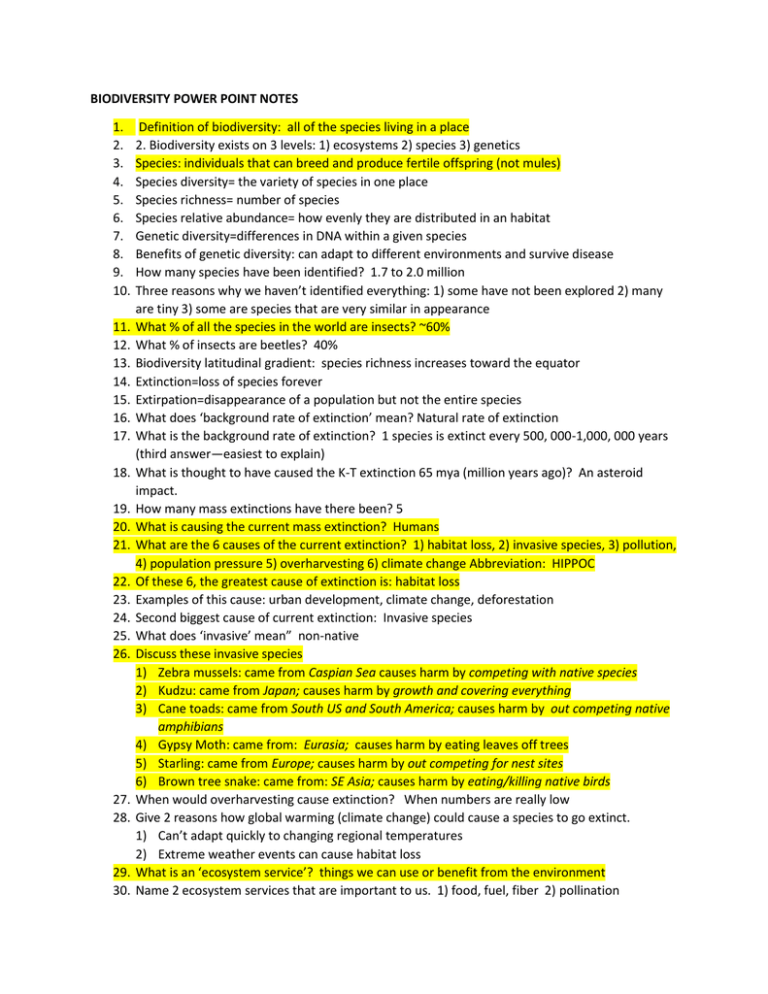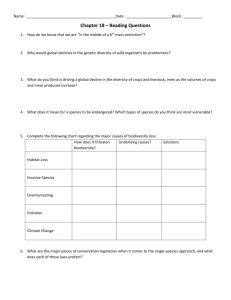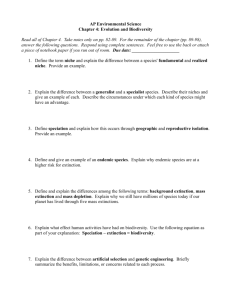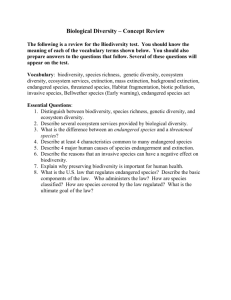BIODIVERSITY POWER POINT NOTES
advertisement

BIODIVERSITY POWER POINT NOTES 1. 2. 3. 4. 5. 6. 7. 8. 9. 10. 11. 12. 13. 14. 15. 16. 17. 18. 19. 20. 21. 22. 23. 24. 25. 26. 27. 28. 29. 30. Definition of biodiversity: all of the species living in a place 2. Biodiversity exists on 3 levels: 1) ecosystems 2) species 3) genetics Species: individuals that can breed and produce fertile offspring (not mules) Species diversity= the variety of species in one place Species richness= number of species Species relative abundance= how evenly they are distributed in an habitat Genetic diversity=differences in DNA within a given species Benefits of genetic diversity: can adapt to different environments and survive disease How many species have been identified? 1.7 to 2.0 million Three reasons why we haven’t identified everything: 1) some have not been explored 2) many are tiny 3) some are species that are very similar in appearance What % of all the species in the world are insects? ~60% What % of insects are beetles? 40% Biodiversity latitudinal gradient: species richness increases toward the equator Extinction=loss of species forever Extirpation=disappearance of a population but not the entire species What does ‘background rate of extinction’ mean? Natural rate of extinction What is the background rate of extinction? 1 species is extinct every 500, 000-1,000, 000 years (third answer—easiest to explain) What is thought to have caused the K-T extinction 65 mya (million years ago)? An asteroid impact. How many mass extinctions have there been? 5 What is causing the current mass extinction? Humans What are the 6 causes of the current extinction? 1) habitat loss, 2) invasive species, 3) pollution, 4) population pressure 5) overharvesting 6) climate change Abbreviation: HIPPOC Of these 6, the greatest cause of extinction is: habitat loss Examples of this cause: urban development, climate change, deforestation Second biggest cause of current extinction: Invasive species What does ‘invasive’ mean” non-native Discuss these invasive species 1) Zebra mussels: came from Caspian Sea causes harm by competing with native species 2) Kudzu: came from Japan; causes harm by growth and covering everything 3) Cane toads: came from South US and South America; causes harm by out competing native amphibians 4) Gypsy Moth: came from: Eurasia; causes harm by eating leaves off trees 5) Starling: came from Europe; causes harm by out competing for nest sites 6) Brown tree snake: came from: SE Asia; causes harm by eating/killing native birds When would overharvesting cause extinction? When numbers are really low Give 2 reasons how global warming (climate change) could cause a species to go extinct. 1) Can’t adapt quickly to changing regional temperatures 2) Extreme weather events can cause habitat loss What is an ‘ecosystem service’? things we can use or benefit from the environment Name 2 ecosystem services that are important to us. 1) food, fuel, fiber 2) pollination 31. What is a ‘keystone’ species? Interacts with many others 32. Give 1 way that biodiversity is good for us food-wise. Many species can be used for food that can be=food security 33. Give 1 way that biodiversity is good for us medicine-wise. Species can be used for new medicines 34. Give 1 way that biodiversity is good for us economically. Tourism, money 35. Define ‘biophilia’ human love for other alive things. Examples: parks & wildlife, pets, landscape, views, etc. 36. What do conservation biologists try to do? Intend to prevent extinction 37. The theory of island biogeography was originally used to describe biodiversity in oceans but then was applied to biodiversity on terrestrial islands (parks) for conservation biology. 38. Parks thought of as: islands 39. Forest fragmentation can cause local extirpation by becoming to small to support them 40. Endangered Species Act, 1973: 1) prevents destruction of habitat 2) forbids trade in products 3) prevents extinction stabilizes and recovers populations 41. Captive breeding: endangered species being bred in 2005. Example: California Condor 42. What is an ‘umbrella species’? serves to protect others Example: Tiger 43. CTES: Convention on International Trade and Endangered Species Year: 1973 44. What does CITES make illegal? Transport of body parts of endangered species 45. ‘Endemic’: found no where else 46. Why do you think part of California is considered a biodiversity hotspot? Has species that are found no where else.









